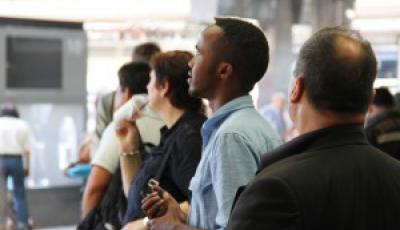Guest post by Asha Siad and Roda Siad, creators of Living at the Border, a multimedia project that documents migrant and refugee stories in Italy. Asha and Roda are Somali-Canadian documentary filmmakers and researchers based in Calgary. Documenting the realities of African refugees and migrants, Living at the Border captures everyday life in Italy. Through their personal stories, this project shows the complexity of their lives as they navigate through the asylum system in Europe.
The European Union implemented the Dublin II Regulation in 2003 to deal with the uncontrolled movement of asylum seekers. The act states refugees must stay in the country they first enter and wait for their papers to be processed. However, this policy in practice simply has not been working. A decade later, the Dublin III Regulation was implemented with the goal of solving the problems left by the first regulation. Due to the lack of government support in Italy, refugees end up living in abandoned public buildings or on the street. Our goal was to document the realities of these individuals in hopes of bringing their issues to the forefront.
In Europe, documents are life. This is a simple fact that Mutala Mohamed repeats over and over again as he sits on a park bench in Piazza Vittorio. These words ring true for the countless migrants and asylum seekers that make the perilous journey every year from North Africa. Mutala, a young Ghanaian asylum seeker, arrived in Italy from Libya three years ago and continues to wait for the one thing that will give him a chance at starting a new life. Yet, a closer look at the policies aimed at refugees and migrants shows that the facts are not as simple as they seem.

The Dublin II Regulation is a policy that’s all too familiar to refugees and asylum seekers in Italy. Implemented in 2003 after a sudden increase in the number of asylum seekers traveling throughout Europe, the Dublin II states that only one EU member is responsible for an individual asylum application. This means that those who enter Europe through Italy must remain in the country until the asylum process is complete.
Due to the backlog of asylum applications and the lack of social welfare provided by the Italian government, refugees often find themselves in a limbo. Many end up traveling to other European countries and staying there until immigration officials intercept them. In some cases, they spend time in detention before being sent back to Italy. New problems await them in Italy as they lose their space in the shelter and find themselves on the streets.
This was the case for Mutala as he waited in a UK detention centre for his return to Italy.
Although the regulation hasn’t prevented refugees from moving throughout the EU, it has been responsible for the large numbers of Dublin returnees in Italy. According to Italian Refugee Council Spokeswoman, Valeria Carlini, Italy is a relatively new asylum country, compared to other EU members. As a result, the support for refugees isn’t as comprehensive as in other countries.
“We spent years thinking asylum-seekers and refugees were an emergency,

“Integration will not happen unless people are taught the language, taught skills they can use to find a job… but a person who is told to wake up, have breakfast at this soup kitchen, lunch there, will not find time for integration.”
While legislators continue drafting new integration policies, the realities for many refugees and asylum seekers remain the same. The impact of this silent humanitarian crisis can be seen daily on the streets of Rome. “When you are given the legal documents and not given any guidance, you lose hope because you don’t know what to do or where to go,” says Mohamed.
In the summer of 2013, the Dublin III Regulation went into effect. Critics of this new European agreement say very little has been changed from the previous Dublin II. Ultimately, however, the effectiveness of this policy will depend on how it’s applied by each Member State.
For years, Italian policymakers have treated forced migration as a crisis. They have used temporary measures, such as short-term aid and increasing spaces in shelters, and assumed these people would eventually return to their countries. However, the situations in many of these countries, including Mohamed’s homeland of Somalia, remains the same. Facing an uncertain future in Europe, life is on hold for many asylum seekers and migrants. As for Mutala, he waits anxiously to begin that new life.
To learn more about Living at the Border, please visit the project website. You can also follow us on Twitter @living_border and like us on Facebook.
For more on asylum seekers in Italy, see Lessons from Lampedusa by Valeria Ferraris and The Injustice of Criminalizing Irregular Immigration by Alessandro Spena.
Want to start a conversation about this topic? Post a comment here or on our Facebook page. You can also tweet us.
__________
How to cite this blog post (Harvard style):
Siad A and Siad R (2014) Living at the Border: Refugee and Migrant Stories from Italy. Available at: http://bordercriminologies.law.ox.ac.uk/living-at-the-border/ (accessed [date]).
Share:








